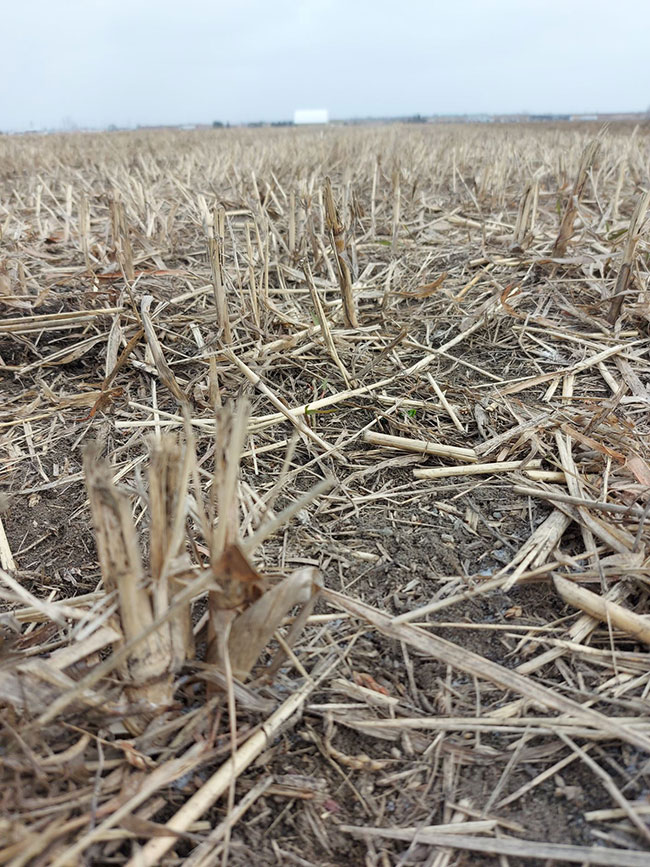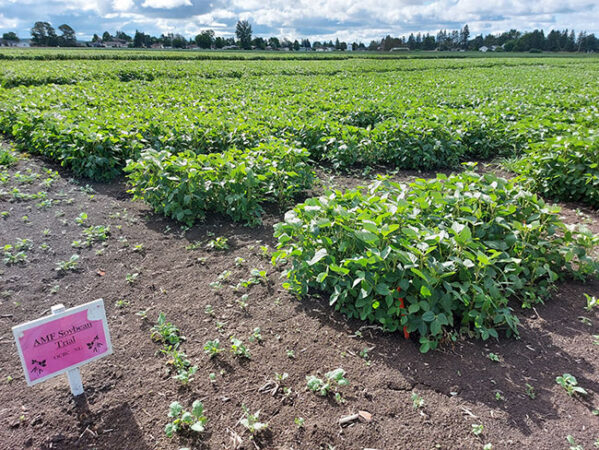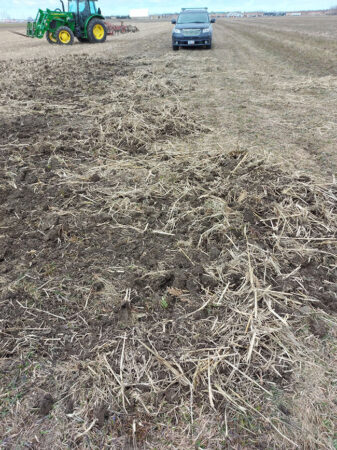
Features
Soil
Exploring AMF inoculant options
Could you boost your crop’s beneficial fungi – and your yields – with your own farm-grown fungi?
March 27, 2023 By Carolyn King
 The project team grew some sorghum-sudangrass, a highly mycorrhizal crop, to produce their own locally adapted inoculum.
All photos courtesy of Melinda Drummond, OCRC-NL.
The project team grew some sorghum-sudangrass, a highly mycorrhizal crop, to produce their own locally adapted inoculum.
All photos courtesy of Melinda Drummond, OCRC-NL.
Communities of helpful fungal species called arbuscular mycorrhizal fungi (AMF) occur naturally in most soils around the world, including crop fields. Research shows these fungi can provide vital benefits to plants. Some crop growers are trying to enhance the pre-existing AMF community in their fields by applying commercial mycorrhizal inoculants.
Now, a northern Ontario project is looking into the possibility of on-farm-produced AMF inoculants and seeing how they compare with commercial inoculants.
“Mycorrhizal fungi are considered obligate symbionts – they completely rely on their host plant for all the carbon they need. The fungi return this favour by providing their host plant with better access to nutrients, especially phosphorus and some other more slowly mobile nutrients,” explains Pedro Antunes, the lead investigator on this project.
AMF can form mutually beneficial relationships with most types of land plants, including crops like wheat, corn and soybeans. This symbiosis involves the fungus colonizing a host plant’s root, growing inside the root, and developing thread-like fungal arms known as hyphae. The hyphae grow beyond the root and explore the soil to acquire nutrients for the plant.
In addition to nutrient acquisition, AMF can provide other perks to their host like increased water access and greater disease tolerance, as well as soil quality benefits like higher soil organic matter content and improved water-holding capacity.
However, some agricultural practices, like using intensive tillage, applying high rates of inorganic fertilizers and growing non-host crops, such as canola, have the potential to degrade a field’s native AMF community.
Antunes, Maren Oelbermann and Joshua Nasielski put together the concept for this field project. All three scientists have agricultural backgrounds, but each brings a different perspective to the research.
Antunes leads the Plant and Soil Ecology Lab at Algoma University, with research interests that include AMF. He also notes, “I’m working in northern Ontario in an area where we are seeing a lot of agricultural fields come back into production. With climate change and the movement of agriculture toward northern latitudes, we have to really rethink how to utilize our soils in a sustainable way.”
Oelbermann leads the University of Waterloo’s Soil Ecosystem Dynamics Lab. “My research area is about soil science in terms of carbon and nitrogen dynamics, greenhouse gases, and general soil health and soil quality aspects,” she says. “I also like to look at the broader picture in terms of how this can all be done in a more sustainable way.”
Nasielski, who heads the Northern and Eastern Ontario Agronomy Research Group at the University of Guelph, brings a crop-science viewpoint to the project. “Greenhouse studies have demonstrated increases in plant growth and yield when AMF products are added. But I am skeptical about how well that translates to a more agronomic context,” he says.
“I think this project is a really interesting, rigorous field test to see if these AMF inoculants can help a farmer out in the real world. A lot of other AMF studies have not looked at grain yield; they might just look at total growth after a couple of weeks. But this project is measuring yields, and moreover, two of our sites are on actual farms.”
Oelbermann, Antunes and Nasielski are thesis advisors to Rachel Boucher, an MSc student at the University of Waterloo who is carrying out the project.

These plots at New Liskeard are part of a project comparing an on-farm-produced mycorrhizal inoculant and a commercial inoculant, applied to soybeans grown after canola.
Project outline
This project is assessing whether a commercial AMF inoculant or a farm-grown AMF inoculant is more effective and sustainable when a soybean crop is grown after canola, under northern Ontario conditions.
The project’s fieldwork took place in 2021 and 2022 at three locations: two on-farm locations east of Sault Ste. Marie, and one location at the Ontario Crops Research Centre in New Liskeard (OCRC-NL).
Nasielski explains that the project targeted northern Ontario locations in part because soil-test phosphorus – which is a measure of plant-available phosphorus – tends to be lower in this region than in southern Ontario.
“In northern Ontario, reclaimed lands, older hay fields, and newly cleared lands can have astoundingly low soil-test phosphorus levels – 5, 6, 7 or 8 parts per million. If these farmers build up their soil-test phosphorus levels by applying phosphate fertilizer, it would be very expensive, with the costs of buying, transporting and spreading the fertilizer,” he says.
“So, instead of raising soil-test phosphorus by adding phosphate, can we make the phosphorus that is already in the soil more available to the plants? That is what AMF can do.”
Oelbermann adds, “This research is a way to look at how we can make ourselves less reliant on commercial phosphorus products, which are going to run out at some point, and see if we can get a long-term, sustainable, locally produced source of phosphorus.”
In 2021, the project team grew canola on the main plot site at each location.
“Plants in the mustard family, like canola, don’t form associations with mycorrhizal fungi. So, we hypothesized that after canola, mycorrhizal abundance and diversity in that soil would go down, and the crop after canola may not receive as much benefit from AMF symbiosis,” says Antunes.
“And we hypothesized that, if we could augment or re-augment the abundance and diversity of the mycorrhizal fungi in that soil by adding an inoculant, then the crop after canola would benefit.”
Also in 2021, the team grew sorghum-sudangrass on a small plot next to the main plot site in order to grow their own AMF inoculum.
Sorghum-sudangrass is a highly mycorrhizal crop. “It provides a lot of carbon to mycorrhizal fungi and it has a very extensive root system. As a result, the soil becomes full of AMF propagules [spores, hyphae and colonized roots, which can be used to propagate AMF]. In fungal collections around the world, when you want to maintain mycorrhizal fungi, you usually use this species,” says Antunes.
“Sorghum-sudangrass is also a very good grass species to grow as a forage crop in northern Ontario. Our thinking is that you could get a two-for-one special: a forage crop and increased mycorrhizal potential.”
In 2022, the team planted the main site to soybean. They implemented three primary treatments: a commercial AMF inoculant; the on-farm-produced inoculant; and a control plot with no inoculant.
Within each of these treatments, they compared three other treatments: 100 per cent of the Ontario recommended rates of phosphorus and potassium; 50 per cent of those rates; and a control with no fertilizer application.
The commercial inoculant was a granular formulation containing a single AMF species that is widely used in such inoculants. Following the product’s label, they applied the inoculant in-furrow at a rate of 0.57 grams per square metre.
For the farm-grown inoculant, the team collected a little of the sorghum-sudangrass plot’s topsoil, which contained the plant’s roots and the soil around the roots.
Only a small amount of this AMF-rich soil was needed to match or exceed the number of AMF spores in the commercial inoculant. According to their tests, the inoculum from the sorghum-sudangrass plot had around 139 spores per gram of soil. They applied it at a rate of 555 grams per square metre, which works out to about 77,000 spores added per square metre. In comparison, the commercial inoculum applied at the label rate added about 80 spores per square metre.
They spread the AMF-rich soil in a thin layer on top of the plots and lightly raked it into the plot soil. “The soybean seeder was able to incorporate this inoculum further, bringing it even closer to the seed. Then we got rain a few days after, helping to spread the spores a bit more,” Boucher notes.
They monitored soybean growth, measured soybean biomass, grain yield and quality, assessed crop health using NDVI (normalized difference vegetation index, which is based on reflected light), conducted a weed census, and measured canopy light. They also collected soil samples to determine nutrient levels and microbial biomass, root samples to assess AMF colonization throughout the season, and plant tissue samples to measure the crop’s nutrient uptake.

The team collected a little of the mycorrhizal-rich soil and roots from the sorghum-sudangrass plot to spread it on the soybean plots.
Inoculant pros and cons
Antunes points out that commercial inoculants and on-farm produced inoculants each have their own pros and cons.
For example, commercial inoculants usually contain a single AMF species isolated from its own particular set of growing conditions. So, a commercial product’s effects are influenced by how its specific AMF strain responds to a particular field’s specific pre-existing microbial community, soil and weather conditions, crop and weed types, and so on.
That likely contributes to the difficulty in predicting how well a commercial inoculant will perform in a specific field. For example, research shows that in some situations, a commercial inoculant could result in higher crop yields. In other situations, the inoculum could fail to even become established. And in some other situations, it could be a ‘weedy’ strain that out-competes more beneficial local AMF species for symbiosis with the crop.
In contrast, on-farm-produced AMF inoculants have multiple AMF species and those species are locally adapted.
“A number of studies demonstrate that the mycorrhizal fungi that are indigenous to a particular soil and particular set of plants seem to provide the best benefits to the plants in their local soil,” notes Antunes.
“Even if we are growing crops introduced from other parts of the world, with no match between the plants and the local AMF, at least on-farm-produced AMF have a match between the fungi and the local soils in that local environment.”
Having multiple local species could also be helpful in responding to changing conditions, like different crops in the rotation and changing weather-related stresses.
The direct costs of the two types of inoculants will depend on various factors. For a commercial inoculant, there would be costs to purchase and apply it. For the farm-grown AMF, assuming you are already growing sorghum-sudangrass for forage, there would be some costs to harvest a little of the AMF-rich soil and spread it. As well, the harvested soil might contain plant pathogens and/or weed seeds.
In addition, of course, either or both types of inoculants might provide economic and environmental advantages compared to the control plots, such as higher soybean yields and lower inorganic fertilizer needs.
Next steps
Now that the project’s field work is finished, Boucher is busy analyzing the data. The team is keen to see how all the pros and cons of the inoculant options balance out in terms of net benefits for soybean production after canola.
“I don’t think we can recommend any specific practices based on this project. It’s more basic, first principles kind of work,” says Nasielski. “But from the response we’ve been getting from presenting this research to farmers, I think they appreciate the learning points, even though it will take a lot more thinking [and experimenting] to develop any specific recommendations.”
Antunes agrees. “This project is a first step in a series of sustainable agriculture studies that need to be done.”
The researchers have several ideas for next steps in this research. For instance, Oelbermann notes the importance of testing the inoculants in different crops and different climatic regions, and of finding ways to minimize soil removal from the sorghum-sudangrass plot.
Nasielski is especially interested in how best to harvest only the sorghum-sudangrass root balls. “The root balls, plus the small amount of soil attached to them, have most of the AMF. At present, we are moving a lot of soil with the root balls.” He wonders if some type of existing field equipment could be modified to separate the root balls from most of the soil.
“We could also look into the underlying factors that affect if and how long the commercial inoculant strains persist in the soil, because it seems to be really context-dependent,” Boucher adds. “And we could examine how the microbial community is altered by adding these inoculants and then how those alterations affect the plants.”
The results of these further studies will help in putting together more of the information that farmers need when making decisions about using AMF inoculants.
This project is funded through the Ontario Agri-Food Research Initiative. In addition to Antunes, Oelbermann, Nasielski and Boucher, the project has a large group of advisors, collaborators and assistants including: Adrian Unc (Memorial University), Lynette Abbott (University of Western Australia), Nathan Mountain (OCRC-NL), Melinda Drummond (OCRC-NL), Mikala Parr (Rural Agri-Innovation Network (RAIN)), Miranda Hart (University of British Columbia-Okanagan), Sebastian Belliard (Ontario Ministry of Agriculture, Food and Rural Affairs), David Thompson (RAIN), Emily Potter (Northern Ontario Farm Innovation Alliance), and Diana Gonzalez Nava (MITACS Globalink intern from Mexico).